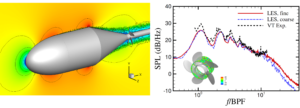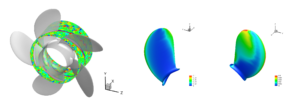1. Evolution of a turbulent boundary layer on the tail cone of a body of revolution under strong adverse pressure gradient
It is well known that turbulent boundary layers (TBLs) under adverse pressure gradient are very common in a lot of engineering applications and are often related to the off-design conditions of engineering devices. An improved understanding of the underlying flow physics can be beneficial to the design as well as optimization of engineering devices, and it is also a prerequisite to the development of effective flow control strategies.
In order to investigate the evolution of axisymmetric TBL in the presence of adverse pressure gradient, the turbulent flow over an axisymmetric body of revolution (BOR) at zero angle of attack is computed using large-eddy simulation (LES). The BOR consists of an ellipsoidal nose, a cylindrical midsection and a 20-degrees tail cone. The Reynolds number based on the free-stream velocity and the BOR length is 1.9 million. Based on the flow-field data from LES, the effects of adverse pressure gradient on the evolution of TBL statistical properties and the change in the flow structures over the tail cone are analyzed. In addition, the applicability of the embedded shear layer scaling in the axisymmetric boundary layer on the tail cone and the space‐time characteristics of pressure fluctuations on the tail cone surface are investigated.

Publications:
- Zhou, D., Wang, K. & Wang, M., Space-Time characteristics of wall-pressure fluctuations beneath an axisymmetric turbulent boundary layer with adverse pressure gradient. (In preparation)
- Zhou, D., Wang, K. & Wang, M., Evolution of a non-equilibrium turbulent boundary layer on the tail cone of a body of revolution under strong adverse pressure gradient. (In preparation)
- Zhou, D., Wang, K. & Wang, M., Large-Eddy simulation of an axisymmetric boundary layer on a body of revolution, AIAA 2020-2989. AIAA AVIATION 2020 FORUM, June 2020.
2. Computational analysis of rotor noise generation in a thick axisymmetric boundary layer
The interaction of a rotor with turbulent inflow is known to be a significant and often dominant source of noise in many engineering systems. An ability to predict the rotor noise and a clear understanding of the noise generation mechanisms are critical to the design and optimization of rotor in engineering devices.
In collaboration with an experimental team from Virginia Tech, I am investigating the generation of noise from a five-bladed rotor ingesting a thick TBL at the tail end of an axisymmetric body of revolution. The noise of rotor-boundary layer interaction is computed using LES and the Ffowcs Williams-Hawkings equation. The calculated far-field sound pressure spectra show broadband turbulence ingestion noise with haystacking spectral peaks near the blade passing frequency and its first three harmonics, which compares well with the experimental data. Based on the flow and sound data from the simulations, the properties of rotor blade acoustic source including the source strength distribution, correlations and their relationships to the turbulent flow field are investigated. The simulation data have also been used to check the validity of Sears theory in predicting the turbulence ingestion noise of rotor.


Publications:
- Zhou, D., Wang, K. & Wang, M., Computation of rotor noise generation in a thick axisymmetric turbulent boundary layer. AIAA AVIATION 2021 FORUM, Aug. 2021 (accepted).